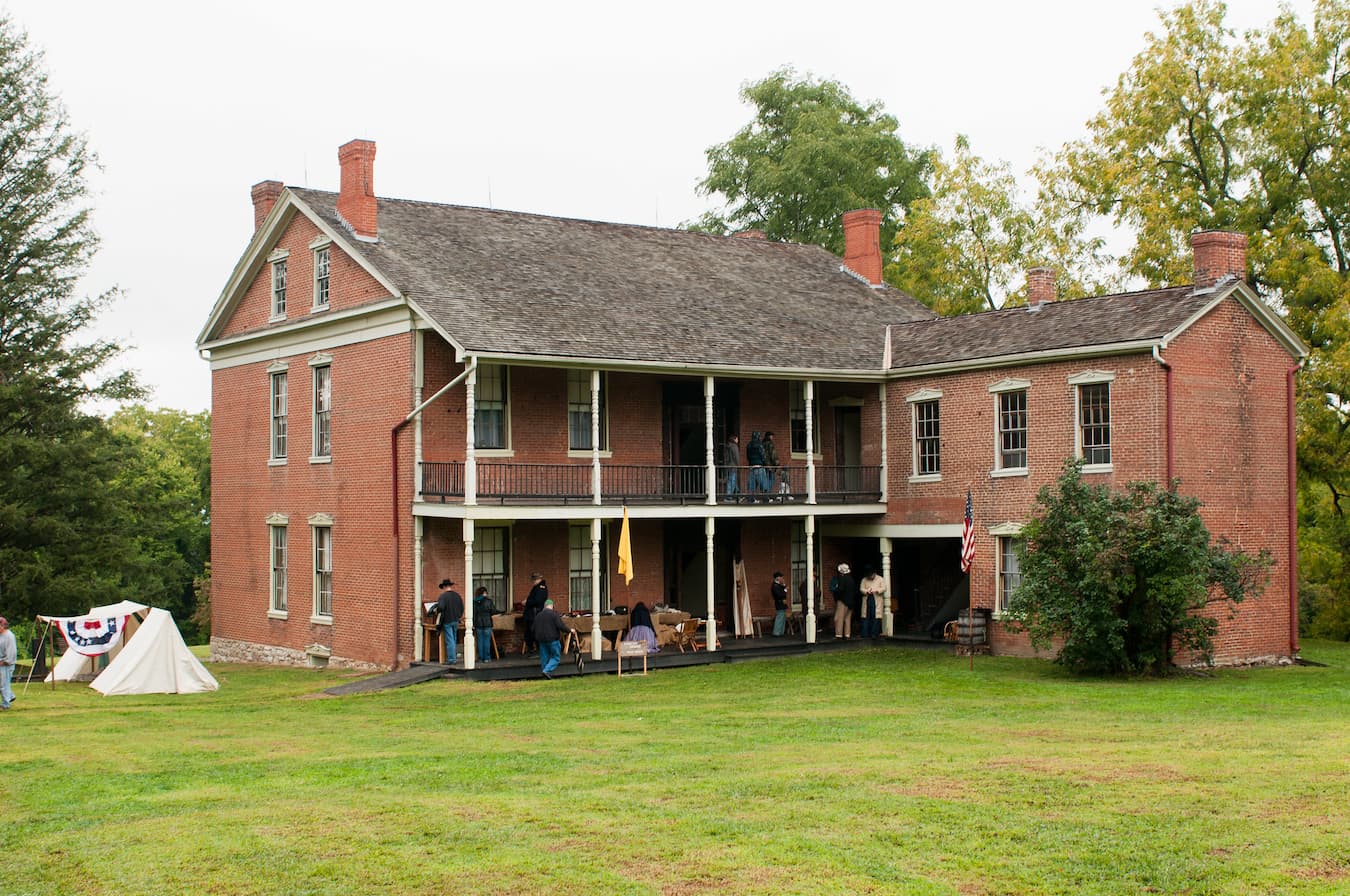Shortly after the Civil War ended, the riverboat Sultana—overloaded with Union soldiers released from Confederate prison camps—began its journey up the Mississippi River. What happened next would become one of America’s worst maritime disasters.

Photo from Wikimedia Commons
By Ron Soodalter
By the time Confederate General-in-Chief Robert E. Lee surrendered to Union Lieutenant General Ulysses S. Grant on April 9, 1865, the Civil War had all but run its course. During its four hellish years, it had wrought the deaths of some 620,000 men and created a million and a half casualties. But hostilities were finally winding down, and it was apparent to all but the most determined holdouts that the South had lost. Now, the Confederate prison camps were opening their gates in a final prisoner exchange, releasing thousands of Union captives. After clinging to life under the most horrific conditions, they were finally going home.
Some 2,000 soldiers—ragged, sickly, newly freed from the nightmarish camps at Andersonville and Cahaba—left the prisoner exchange camp at Vicksburg and boarded the Sultana, a Missouri-based, 260-foot-long, 42-foot-wide steamboat. Sharing the boat with them were 100 civilians; 85 crewmen; 12 Sisters of Charity; 60 horses and mules; and an alligator, crated in the bulkhead, that served as the boat’s mascot. Although the legal limit for passengers was only 376, some 2,100 people stood crammed together on the Ohio-bound vessel as she steamed up the Mississippi. No boat on the Mississippi River had ever carried such a large complement of passengers. Apparently, the soldiers had little issue with the overcrowding; all that mattered to them was that the boat was carrying them home.
Like many Mississippi riverboats, the Sultana was well-appointed; the long, luxurious main cabin was replete with fine carpets and furnishings. The tables were set with china plates, and chandeliers hung from the ceiling. To compensate for the paucity of on-board restrooms, maids visited each stateroom daily to empty the chamber pots. No amount of convenience or luxury, however, could accommodate this massive crowd, nor compensate for the avarice and neglect that would result in the cataclysm yet to come.
Prelude to Tragedy
Most of the Missouri soldiers recently released from Confederate prison camps had been conveyed to Jefferson Barracks south of St. Louis, on an earlier vessel. However, since St. Louis was the Sultana’s home port, many of her crewmen and officers, as well as the clerk responsible for assigning tickets to the passengers, were Missourians.
The Sultana’s captain and part owner, 33-year-old St. Louis native James Cass Mason, had often raced the boat for money; he lost frequently, and he saw this trip as an opportunity to restore his finances. He received a fee for every soldier who boarded his boat— five dollars per enlisted man and ten per officer (nearly $100 and $200, respectively, in today’s currency)—and his rapaciousness overcame both his professionalism and his common sense. Mason, in collusion with corrupt Union quartermaster Reuben Hatch, managed to cram aboard as many passengers as he could, while still keeping the vessel afloat. The last photograph taken of the Sultana shows an unbroken mass of people standing not only on the boat’s main deck but crowding her other three decks as well. No level part of the boat was free of passengers, and with a draft of less than three feet, the load rendered her impossibly top-heavy, and caused her to roll from side to side.
Sultana left Vicksburg on the morning of April 25, bound for Ohio against a strong spring-flood current. Two days later, she docked at Memphis, then crossed the river to the Arkansas side, where she picked up a load of coal.
Hell on Water
At around two o’clock in the morning on April 27, with the vessel seven miles north of Memphis, the unthinkable happened. A tremendous explosion lit up the black, rainy night, as the Sultana’s four boilers exploded. The pilot house was immediately blown over the side, taking with it first mate William Rowberry of St. Louis. Rowberry was among the few to survive.
The thin wood that made up the vessel immediately caught fire, and the Sultana was soon an inferno. The vessel’s life support systems were negligible; some of the crew, disregarding the safety of the passengers, commandeered Sultana’s one lifeboat and escaped the holocaust. All that remained was a handful of lifebelts, which were desperately fought over, and served but little good. Mason used two of the lifebelts in attempt to save the life of his wife and daughter
Those who weren’t immediately blown into the water or caught in the fire now had two equally dismal options: jump into the river, which was three miles wide, raging, and frigid with snowmelt, or face an equally horrific end by staying on the boat and perishing in the flames. The river had flooded its banks, and in the dark it was virtually impossible to see the land on either side. Nonetheless, countless starved and debilitated soldiers, many of whom couldn’t swim, chose to brave the river rather than burn to death. Unable to battle the tremendous current, hundreds drowned. For many who clung to logs, planks, or debris from the burning boat, as well as for the fortunate few who actually reached the shore, there was the real possibility of death from hypothermia and exposure.

Photo from Wikimedia Commons
Captain J. Walter Elliott of the 44th Regiment, United States Colored Infantry, later wrote of finding a soldier calmly sitting on his cot, “bruised, cut, scalded in various places, both ankles broken and bones protruding.” Elliot explained to the man that he was powerless to help him: “I cannot swim.” The grievously injured man then begged the captain for a last favor: “Throw me in the river is all I ask, else I shall burn to death here.”
Survivor Rev. Chester D. Berry wrote, “Hundreds were forced into the water and drowned in huge squads, those who could swim being unable to get away from those who could not, and consequently perishing with them.” Another recalled, “When I got about three hundred yards away from the boat clinging to a heavy plank, the whole heavens seemed to be lighted up by the conflagration. Hundreds of my comrades were fastened down by the timbers on the decks and had to burn while the water seemed to be one solid mass of human beings struggling with the waves.”
Some men tried to avoid a watery death by holding onto the vessel’s hull for as long as they could. A survivor recalled, “The men who were afraid to take to the water could be seen clinging to the sides of the bow of the boat until they were singed off like flies.”
Private William Lugenbeal of the 135th Ohio Volunteer Infantry found a unique method of survival. Recalling the boat’s mascot, he slew the alligator with his bayonet and commandeered the wooden cage. “I took off all my clothing except my drawers, drew the box to the end of the boat, threw it overboard and jumped after it. … When I came up, I got a good hold of it and drew myself into it with my feet out behind, so I could kick.” When others attempted to share his “life raft,” he would kick them away, reasoning, “If they had got ahold of me, we would both have drowned.” He floated downriver on the crate until he was picked up by a rescue boat three miles above Memphis.
Upriver, the steamer Bostonia No. 2 sighted the flames, and rushed to the scene. The crew threw hay bales as life supports to those in the water, and picked up all the survivors they could. With the dawn, other rescue boats set out from Memphis, but the mortality rate was staggering.
After the explosion, the wreck of the steamboat drifted with the current some six miles, coming to rest on the Mississippi’s west bank, where she burned to the waterline and sank. Today, what remains of the ill-fated Sultana lies two miles from the water’s edge, a result of the river’s ever-changing course, beneath the sod of a Marion, Arkansas soybean field.
Horror after Terror
The aftermath was nearly as horrific as the explosion itself. As Stephen J. Taylor writes in an online article for Hoosier State Chronicles, “Survivors told of the stench of burning flesh coming off the boat. Decomposing corpses would be found along more than a hundred miles of the river for months. Bodies had to be picked out of trees as far south as Vicksburg. Many victims were never found.”
Nearly 1,200 people died of burns, drowning, exposure, or a combination of the three. In the end, Captain Mason paid dearly for his role in the tragedy. Sergeant Joseph Stevens of the 1st Michigan Sharpshooters later wrote, “I can well remember seeing the captain putting life preservers on his wife and little girl and letting them overboard. The girl’s life preserver slipped too far down for she was found [drowned] with her feet upwards. His wife was saved and the captain lost his life in trying to save others.”
Immediately upon his return to St. Louis, First Mate Rowberry began spreading rumors that the explosion was the result of Confederate sabotage, and the suspicion has endured to the present day. It is a tempting conclusion. In late 1863, a rebel captain named Thomas Edgeworth Courtenay developed a unique item that he referred to as the “coal shell,” although it was generally known as the coal torpedo. Its design was simplicity itself: a hollow iron casting, made in the shape of a lump of coal. A small opening allowed for the cavity to be filled with black powder, and secured by means of a threaded screw. When the torpedo was painted with tar and covered in coal dust, it became indistinguishable from a piece of coal. The plan was to surreptitiously place the bomb in the coal pile of a Union vessel. Once shoveled into the firebox beneath a boat’s boiler, it would gradually heat up until the powder ignited, causing the boiler to explode, damaging, or sinking the vessel.
Lending fuel to the rumor that the Sultana incident resulted from Southern sabotage, a former Confederate secret operative and known saboteur named Robert Lowden reportedly made a death-bed confession. According to a May 8, 1888, Memphis Daily Appeal article, St. Louisan William C. Streeter claimed he had heard Lowden confess to smuggling aboard the Sultana “a large lump of coal in which was concealed a torpedo. This he deposited on the fuel pile in front of the boilers for the express purpose of causing the destruction of the boat.”
After extensive research, however, Sultana authority Gene Eric Salecker has credibly determined that the explosion could not have been the result of sabotage. “The boilers blew from the back top at a 45-degree angle,” he says, “blowing the pilot house off the boat. A coal torpedo could never have done this sort of damage. It would have damaged the thin hull, immediately sinking the vessel, whereas it remained afloat for another six hours.”
The findings of the subsequent board of inquiry support Salecker’s findings. It attributed the sinking of the Sultana to negligence on the part of the engineer, stating that he had failed to keep the water in the boilers sufficiently high. The engineer on duty at the time of the explosion, like much of the crew, hailed from St. Louis. Samuel Clemens—not the author better known as Mark Twain—was mortally scalded by the blast but lived long enough to give a brief statement. As the significant weight of the passengers caused the boat to constantly list from side to side, the outside boiler would go dry and become overheated; then, as the boat righted itself, the water would flood back into the hot, empty boiler, creating steam and a sufficient pressure surge to cause an explosion.
Regardless of whether the cause of the disaster was greed, human error, or sabotage, the tragedy was compounded by the fact that the soldiers who perished in the explosion had managed to survive four horrific years of war, much of it spent in the unimaginable hell of prison camps, only to die on their way home. Interestingly, the tremendous loss of life, while initially shocking, went virtually unremarked, given the assassination of President Lincoln two weeks earlier, and the end of a war that had already claimed so many lives. It was now a time in which Americans sought to put the horrors of war behind them and move toward a much-needed peace.
And so it has gone for more than a century and a half. While a handful of scholars have written books on the event, and it has been featured in a few television and film documentaries, it is a safe bet that most Americans are unaware that the single greatest maritime tragedy in all of American history was was the destruction of the Sultana and the horrific deaths of nearly 1,200 of her passengers.
The sinking of the Sultana still holds great interest for Civil War history lovers, as well as the descendants of those caught up in the tragedy. In 1987, they established the Sultana Association of Descendants and Friends. They welcome new members.
Featured image courtesy of the Library of Congress.
Article originally published in the May 2024 issue of Missouri Life.
Related Posts
Battle of the Hemp Bales
Take in all of the Civil War history that fills the Anderson House and the nearby 100-acre battlefield. Find out all about the Battle of Hemp Bales and relive what a field hospital was really like.
Civil War History at the Battle of Carthage State Historic Site.
More than 1,100 Civil War battles were fought in Missouri. Our state parks system focuses on six sites. The Battle of Carthage State Historic Site is one not to be missed. There are interpretive displays and a Civil War museum near the square in Carthage, as well as the fields where the battles took place.
Missouri History Today October 31, 1895: Central Mississippi Valley Jolted By Major Earthquake
Missouri History Today October 31, 1895: Central Mississippi Valley Jolted By Major Earthquake
Prehistoric Indian Sites and the “Cannonball House.”
Learn how the site of an early Civil War skirmish became a State Historic Site. Uncover prehistoric Indian sites and part of a Sauk Indian village. Take a hike to see rich flora that are relics of glacial times. Can you find the “cannonball house?”




